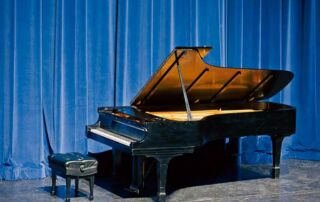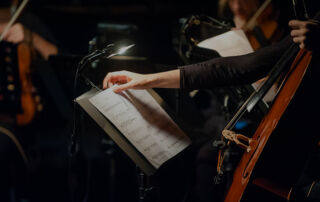The double bass emerged in 1620, succeeding the violone and the violone bass, but it was not introduced into the orchestra until the mid-17th century.
It was first used in a French orchestra in 1706 by Marin Marais in the storm scene of his opera Alcyone.
Initially, it doubled the cello parts an octave lower, but over time, it gained independence, and double basses gradually received their own parts in orchestras.
The five-string double bass quickly spread in Italy, Germany, and Austria, but its arrival in France was relatively late. Initially, it was used primarily in churches, where it reinforced the lower register of the organ.
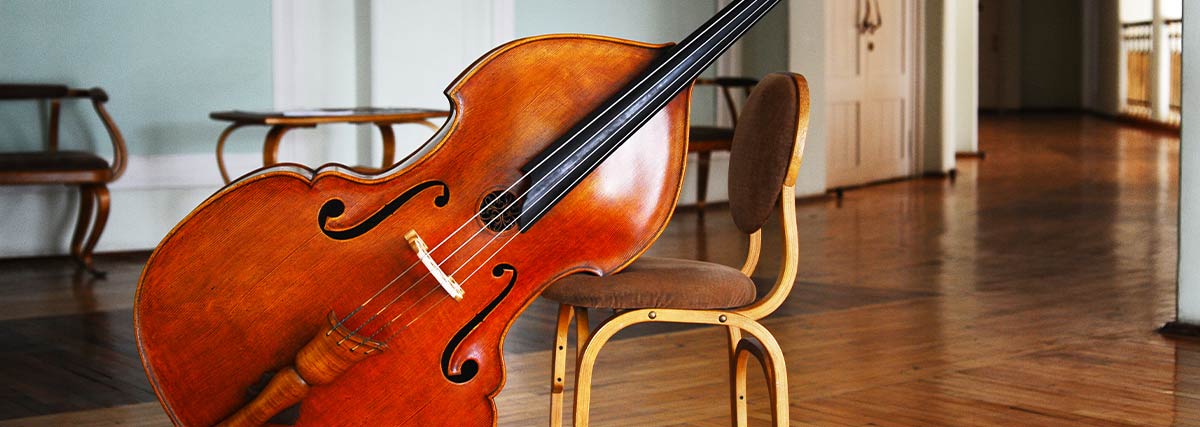
The instrument
The double bass is the largest and lowest-pitched instrument in the string family. Unlike the other instruments in the quartet – violin, viola, and cello – there is no single standard model of double bass; some have four strings, while others have five.
The four-string double bass (G, D, A, E from highest to lowest) is the most commonly used.
It can be played by bowing the strings (arco) or plucking them with the fingers (pizzicato). The double bass is widely used in classical music within symphony orchestras, chamber orchestras, contemporary music, and electronic music as a synthetic double bass.
In jazz, it is part of the rhythm section and is also used in other styles such as blues, rock 'n' roll, rockabilly, jazz rap, and tango.
The size of the double bass is not standardised: its height can reach 1.95 metres, with a body length of 1.10 metres, but the most common models measure 1.80 metres.
The wood used for constructing double basses is typically spruce for the top, maple for the body, and ebony for the fingerboard, but carbon fibre double basses also exist.
The double bass consists of several parts: the scroll, neck, top, bridge, strings (attached to the tailpiece and tuning pegs), f-holes, and endpin.

Variations of double basses
Several historical variations of the double bass are still played today, including the violone, the octobass, and three-string double basses.
Electric double basses resemble the traditional double bass but lack the large resonating body. Instead, they use a built-in pickup attached to the bridge, which is connected to an amplifier.
Electric double basses are often used by jazz-rock or fusion musicians.
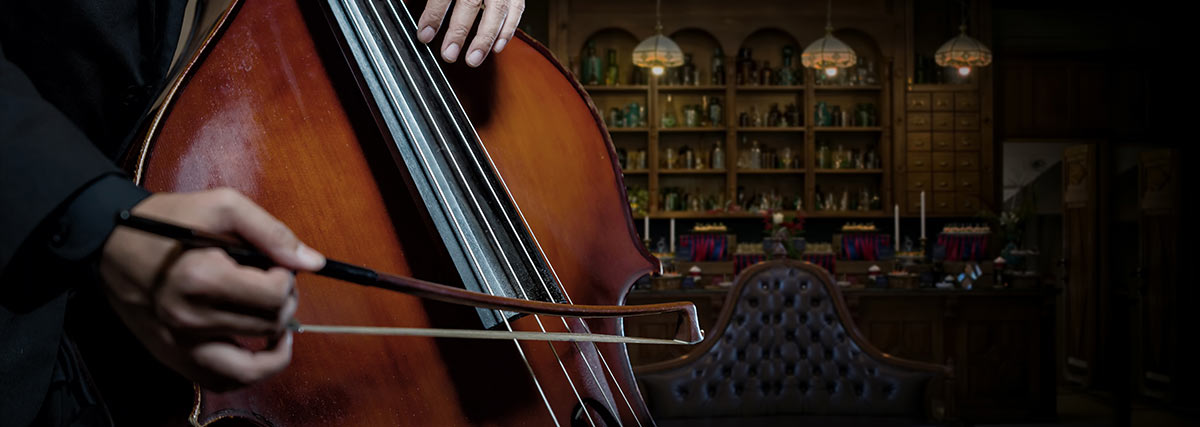
The bow
The shape of the bow has never been completely standardised, and several types of sticks exist: arched – like those of the viola da gamba – straight, or slightly curved towards the hair.
There are two types of bows for the double bass: the French bow, similar to those of other instruments in the violin family and held in the same way, and the German bow, which is shorter and held differently, resembling the bow of the viola da gamba.
The German bow is much older than the French bow, which was rarely used before the 1800s.
The majority of bows are made from pernambuco, a Brazilian wood, but some can be made from carbon fibre.
The different parts of a double bass bow are the same as those found on instruments in the violin family: the head, stick, button, head plate, horsehair, eye, and frog.

The double bass in musical ensembles
Double basses form the fifth section of the bowed strings in the symphony orchestra, following the first violins, second violins, violas, and cellos.
The different right-hand playing techniques:
- Martelé: The bow pauses between each note to produce staccato sounds.
- Sautillé: The bow bounces on the strings.
- Col legno: The wood of the bow is used to produce sound (by striking or rubbing).
- Sul tasto: A playing technique where the bow is drawn over the strings above the fingerboard, producing a very soft and velvety sound.
- Sul ponticello: A playing technique where the bow is drawn very close to the bridge.
- Pizzicato: The double bassist plucks the strings with their fingers.
- Bartók pizzicato: This technique involves pulling the string vertically so that it snaps against the fingerboard.
- Tremolo: By rapidly pulling and pushing, the bow repeats a note in quick succession.
- Bariolage: The bow quickly moves from string to string.
- Double stops: The bow moves across two strings simultaneously to play two notes at once.

Where are the double basses positioned in a symphony orchestra?
The double basses are usually positioned behind the cellos, but sometimes they may be placed differently.
In a chamber orchestra, the double bass is part of the bowed string quintet.
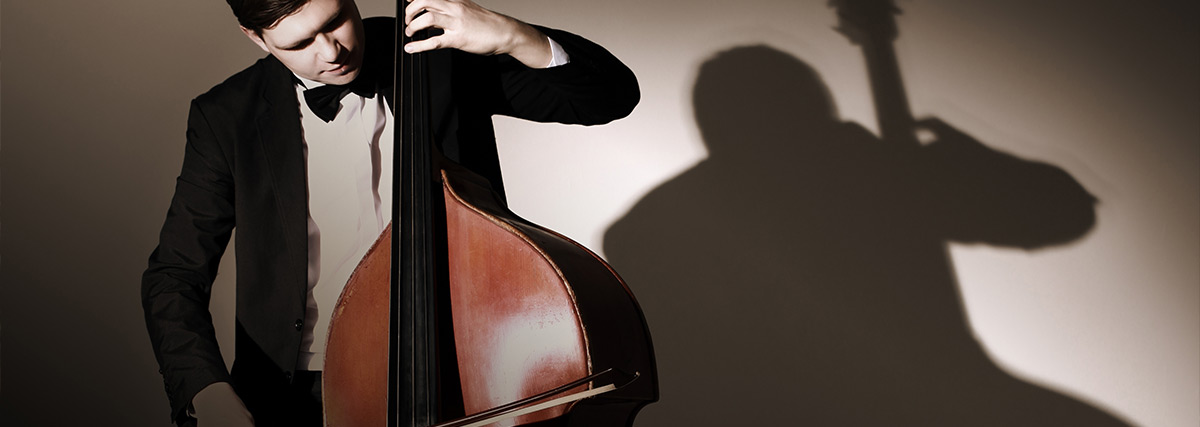
Répertoire pour contrebasse :
The major concertos composed for the instrument:D. Dragonetti, G.Bottesini, J.B. Vanhal, K.D. Von Dittersdorf, S.Koussevitzky, V. Mortari.
Many concertos and pieces originally written for the cello, such as the Suites for Solo Cello by Bach, have been transcribed for the double bass.
Other pieces for double bass:
- The Elephant, a piece from The Carnival of the Animals by C. Saint-Saëns
- Quintets with Double Bass Op. 39 by L. Boccherini
- Quintets for String Quartet and Double Bass by A. Dvořák and D. Milhaud
- Quintet for Oboe, Violin, Viola, Cello, and Double Bass in B Minor by A. Reicha
- The Trout Quintet by F. Schubert for piano, violin, viola, cello, and double bass
- Quintet for Oboe, Clarinet, Violin, Viola, and Double Bass by S. Prokofiev
The contemporary repertoire is particularly abundant, including solo, acoustic, and electronic works.


